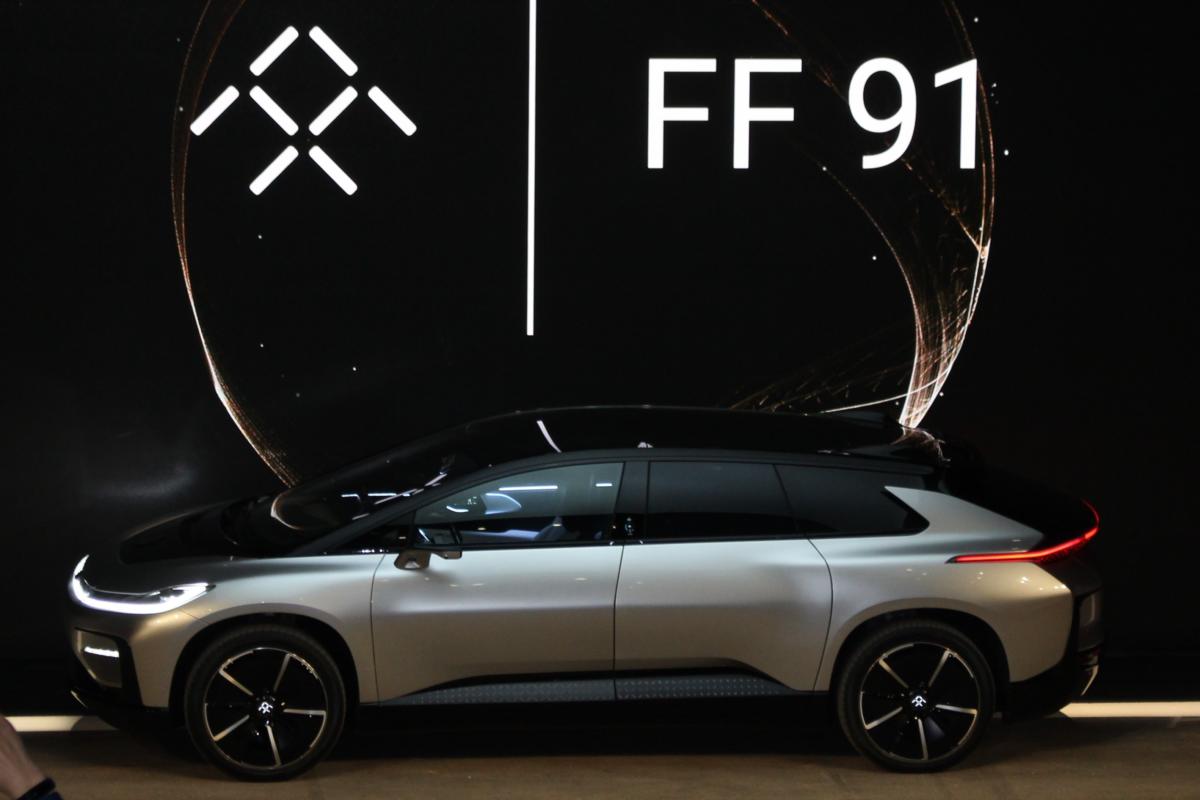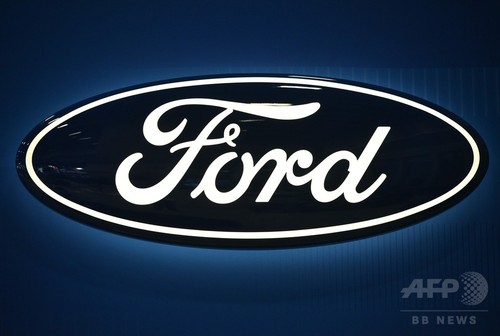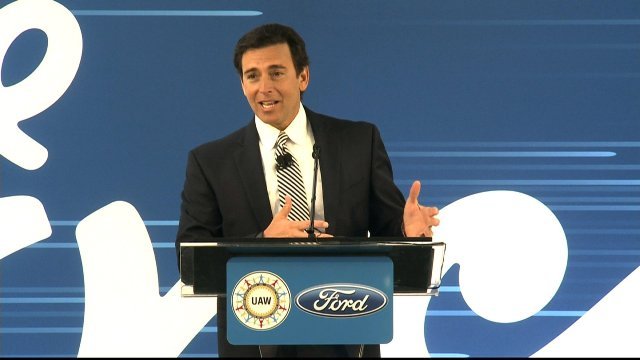Faraday Future’s FF 91 is an SUV-shaped supercar with a lot of promises to keep
 Faraday Future unveiled the FF 91, its first production EV, at CES in Las Vegas Tuesday night. Unlike the fantasy racecar at last year’s show, the FF 91 (pronounced “nine-one”) actually moved and drove—drove itself, parked itself, and did 0-60 in 2.39 seconds live onstage (with a driver). Also unlike last year’s car, Faraday has plans for the FF 91, including the production of 300 limited editions in March and mass production sometime in 2018.
Faraday Future unveiled the FF 91, its first production EV, at CES in Las Vegas Tuesday night. Unlike the fantasy racecar at last year’s show, the FF 91 (pronounced “nine-one”) actually moved and drove—drove itself, parked itself, and did 0-60 in 2.39 seconds live onstage (with a driver). Also unlike last year’s car, Faraday has plans for the FF 91, including the production of 300 limited editions in March and mass production sometime in 2018.
The interior of Faraday Future’s FF 91 is designed to be luxurious, and customizable to the driver’s and passengers’ needs.
That’s big talk from a company with known financial troubles, underscored by a recent, steady stream of executive departures. Key players remain, like Sampson and Richard Kim, the vice president of design. Still, it’s hard to know what FF can realistically accomplish in a still-volatile EV market. Consider that Tesla, a far more established EV company, still struggles with financial and production problems.
Faraday Future’s job on Tuesday night was simply to prove it has something real. It started by showing how the FF 91 could park itself, which it did live in the lot outside of the press conference.
The demo had its hiccups: The car took a long time to find the free spot, and as with other automated parking systems we’ve seen, it had to drive itself all the way past the parking spot to see it as empty, whereas humans can see the spot ahead and go straight into it.
Faraday Future showed off the automated parking feature on the FF 91.
The FF 91 can drive itself because it contains a raft of sensing technology, far more than I’ve seen on any other self-driving car prototype: 10 front- and rear-facing cameras; 13 long- and short-range radars; 12 ultrasonic sensors; and one high-definition 3D LiDAR.
That LiDAR is distinctive for being integrated into the hood of the FF 91. Where other automakers are trying to hide this bulky component, Faraday Future gave its LiDAR a glowing blue circle to show when it’s operating, and it can also rise out of the hood like a high-tech periscope.
After its parking adventure, the FF 91 drove itself onto the stage, with Vice President of Propulsion Engineering Peter Savagian riding in the driver’s seat.
Faraday Future tested the acceleration of its FF 91 against the Tesla Model X (shown) and other prominent competitors.
Savagian got to show the sizzle. He started with videos of 0-60 acceleration tests that pitted the FF 91 against Tesla, Ferrari, and Bentley competitors. All EV fans know that one of the joys of the technology is the instant torque that shoves you back in your seat while traditional transmissions are still working their way through the gears. Guess what: The FF 91 smoked them all.
To underscore the results, Savagian trotted out all the competitors to repeat their 0-60 acceleration tests live onstage. As each car shot away, Savagian took swipes at all the noise and smell from the Ferrari and Bentley’s internal combustion engines, compared to the swift, yet silent Tesla and Faraday Future cars. The FF 91 smoked them all again, though by a mere hundredths of a second over the Tesla Model S 100D.
Faraday Future’s CES press conference included live acceleration tests from Ferrari, Tesla, and Bentley automobiles, as well as its FF 91.
Okay, so the car can move. The next step is to make more of them. Faraday Future is starting with a splashy soft launch, where it will sell 300 limited editions of the FF 91 in March—yes, just two months away. The company will also assert its environmental friendliness by donating part of the profit from the limited edition to an environmental group yet to be named, and auctioning off an FF 91 for the direct benefit of that group.
Making 300 cars is a good start, but it’s another thing altogether to mass-produce thousands. Faraday Future said it would start doing that sometime in 2018, and it opened reservations for those cars Tuesday night. All you have to do is plunk down $5,000 (refundable) to get in line for the FF 91.
Faraday Future’s FF 91 is shown as it prepares to accelerate from 0 to 60 in less than 2.4 seconds.
The fact that this deposit is five times bigger than the $1,000 deposit for the Tesla Model 3 doesn’t mean the FF 91 will cost five times as much in total—Faraday Future actually hasn’t set a price yet, though given all the technology, it will likely be expensive. The higher deposit does suggest that Faraday Future is looking for serious and well-heeled buyers. If you want one of the special limited editions coming in March, you’ll need to upgrade that reservation deposit by an unspecified amount.
A lot of people expect Faraday Future to fail. The company has many interesting ideas and seems committed to its EV mission, but it may just plain run out of money and executives before it can reach the point of sustainability. Even the self-driving tech looks a little shaky, as an FF 91 balked at driving onstage during the last part of the presentation. But if enthusiasm and optimism can combat adversity, the Faraday Future executives that remain displayed gobs of it. Nick Sampson’s last words at the close of the event were almost poignant in their defiance: “Despite all the naysayers and skeptics,” he said, “we will persist. We will carry on.”
© Source: http://www.pcworld.com/article/3154397/consumer-electronics/faraday-futures-ff-91-is-an-suv-shaped-supercar-with-a-lot-of-promises-to-keep.html
All rights are reserved and belongs to a source media.


 Двое украинских военнослужащих получили ранения в зоне проведения антитеррористической операции на востоке страны за минувшие сутки, сообщил спикер Министерства обороны Украины по вопросам АТО Александр Мотузяник.
Двое украинских военнослужащих получили ранения в зоне проведения антитеррористической операции на востоке страны за минувшие сутки, сообщил спикер Министерства обороны Украины по вопросам АТО Александр Мотузяник. 
 Президент Украины Петр Порошенко подписал Закон “О внесении изменений в некоторые законодательные акты Украины относительно усовершенствования порядка прохождения военной службы”.
Президент Украины Петр Порошенко подписал Закон “О внесении изменений в некоторые законодательные акты Украины относительно усовершенствования порядка прохождения военной службы”. 
 【ワシントンAFP=時事】米歌手ジャネット・ジャクソンさんが3日、夫でカタールの実業家ウィサム・アル・マナさんとの間で、第1子となる長男イーサちゃんを出産した。米メディアが伝えた。ジャネットさんは50歳。報道担当者は芸能誌ピープルに「ストレスも問題もないお産で、ジャネットは安らかに静養している」と述べた。 「ポップの王様」と呼ばれた故マイケル・ジャクソンさんの妹のジャネットさんは昨年4月、「家族をもうける計画だ」として、世界ツアーの中断を発表し、ファンを驚かせた。同10月にはピープル誌が、浜辺で膨らんだおなかを抱えるジャネットさんの写真を掲載していた。(2017/01/04-09:48)
【ワシントンAFP=時事】米歌手ジャネット・ジャクソンさんが3日、夫でカタールの実業家ウィサム・アル・マナさんとの間で、第1子となる長男イーサちゃんを出産した。米メディアが伝えた。ジャネットさんは50歳。報道担当者は芸能誌ピープルに「ストレスも問題もないお産で、ジャネットは安らかに静養している」と述べた。 「ポップの王様」と呼ばれた故マイケル・ジャクソンさんの妹のジャネットさんは昨年4月、「家族をもうける計画だ」として、世界ツアーの中断を発表し、ファンを驚かせた。同10月にはピープル誌が、浜辺で膨らんだおなかを抱えるジャネットさんの写真を掲載していた。(2017/01/04-09:48)
 伊勢神宮の参拝を終え、年頭の記者会見をする安倍晋三首相=4日午後、三重県伊勢市
伊勢神宮の参拝を終え、年頭の記者会見をする安倍晋三首相=4日午後、三重県伊勢市 
 【1月4日 AFP】米フォード・モーター( Ford Motor )は3日、メキシコに新工場を建設する計画を撤回すると発表した。同社によるメキシコ工場新設をめぐっては、米国の雇用を重視するドナルド・トランプ( Donald Trump )次期米大統領が再三批判していた。そのトランプ氏は、メキシコで生産した車を米国に輸入している米ゼネラル・モーターズ( GM )にも新たに矛先を向けた。
【1月4日 AFP】米フォード・モーター( Ford Motor )は3日、メキシコに新工場を建設する計画を撤回すると発表した。同社によるメキシコ工場新設をめぐっては、米国の雇用を重視するドナルド・トランプ( Donald Trump )次期米大統領が再三批判していた。そのトランプ氏は、メキシコで生産した車を米国に輸入している米ゼネラル・モーターズ( GM )にも新たに矛先を向けた。 
 ニューヨーク(CNNMoney) 米自動車大手フォードがメキシコで計画していた新工場の建設を中止し、ミシガン州で新たに700人を雇用する方針を明らかにした。
ニューヨーク(CNNMoney) 米自動車大手フォードがメキシコで計画していた新工場の建設を中止し、ミシガン州で新たに700人を雇用する方針を明らかにした。 
 2017年の大発会となった4日の東京株式市場で日経平均株価は4営業日ぶりに大幅反発し、4年ぶりに大発会で上昇した。終値は前営業日比479円79銭(2.51%)高い1万9594円16銭で、16年12月20日以来2週間ぶりに昨年来高値を更新した。終値で1万9500円台を回復するのは15年12月7日以来1年1カ月ぶり。世界景気の回復期待を手がかりに投資家のリスク選好姿勢が広がった。国内勢は利益確定売りを出したものの、海外勢の買いの勢いが強かった。値上がり銘柄数は1851と全体の92%超を占め、トランプ相場開始直後の16年11月10日(1935)以来2カ月ぶりの多さとなった。 画像の拡大 400円超値上がりし、1万9500円台で取引を終えた日経平均株価(4日午後、東京都中央区) 日本市場が休場の間に発表された米中の経済指標を受け、市場心理が好転した。3日に米サプライマネジメント協会(ISM)が発表した16年12月の製造業景況感指数が市場予想を上回ったうえ、中国国家統計局などが1日公表した16年12月の製造業購買担当者景気指数(PMI)が5カ月続けて景気判断の節目となる50を上回った。ヘッジファンドに加えて年金など中長期の海外勢の資金が流入するなか、後場に欧州勢が取引に参加する時間帯に入ると、日経平均は騰勢を強めた。円相場が1ドル=118円台前半まで下げ幅を広げ、輸出関連株に買いが入ったことも相場を押し上げた。 JPX日経インデックス400は3営業日ぶりに反発した。終値は前営業日比324.06ポイント(2.38%)高の1万3938.86だった。東証株価指数(TOPIX)は続伸し、35.87ポイント(2.36%)高の1554.48で終えた。どちらも昨年来高値を更新した。 東証1部の売買代金は概算で2兆6851億円。売買高は23億7573万株だった。東証1部の値上がり銘柄数は1851と、全体の92.3%を占めた。値下がりは121、変わらずは31銘柄だった。 JFE や T&D が一段高となった。 住友不 や 大和 の上げも大きかった。 スズキ が昨年来高値を付け、 ホンダ や トヨタ が上昇した。 三菱UFJ や りそなHD など銀行株の上げも目立った。半面、米アップルがiPhoneを17年1~3月期に前年同期比1割程度、減産すると伝わり、アップルに部品を供給しているとされる アルプス が逆行安となった。 東芝 や 小野薬 は下落。 花王 や 大塚HD の下げも目立った。 東証2部株価指数は続伸し、昨年来高値を更新した。 シャープ と フュトレック が上げ、 マーキュリア と フライトHD が下げた。〔日経QUICKニュース(NQN)〕
2017年の大発会となった4日の東京株式市場で日経平均株価は4営業日ぶりに大幅反発し、4年ぶりに大発会で上昇した。終値は前営業日比479円79銭(2.51%)高い1万9594円16銭で、16年12月20日以来2週間ぶりに昨年来高値を更新した。終値で1万9500円台を回復するのは15年12月7日以来1年1カ月ぶり。世界景気の回復期待を手がかりに投資家のリスク選好姿勢が広がった。国内勢は利益確定売りを出したものの、海外勢の買いの勢いが強かった。値上がり銘柄数は1851と全体の92%超を占め、トランプ相場開始直後の16年11月10日(1935)以来2カ月ぶりの多さとなった。 画像の拡大 400円超値上がりし、1万9500円台で取引を終えた日経平均株価(4日午後、東京都中央区) 日本市場が休場の間に発表された米中の経済指標を受け、市場心理が好転した。3日に米サプライマネジメント協会(ISM)が発表した16年12月の製造業景況感指数が市場予想を上回ったうえ、中国国家統計局などが1日公表した16年12月の製造業購買担当者景気指数(PMI)が5カ月続けて景気判断の節目となる50を上回った。ヘッジファンドに加えて年金など中長期の海外勢の資金が流入するなか、後場に欧州勢が取引に参加する時間帯に入ると、日経平均は騰勢を強めた。円相場が1ドル=118円台前半まで下げ幅を広げ、輸出関連株に買いが入ったことも相場を押し上げた。 JPX日経インデックス400は3営業日ぶりに反発した。終値は前営業日比324.06ポイント(2.38%)高の1万3938.86だった。東証株価指数(TOPIX)は続伸し、35.87ポイント(2.36%)高の1554.48で終えた。どちらも昨年来高値を更新した。 東証1部の売買代金は概算で2兆6851億円。売買高は23億7573万株だった。東証1部の値上がり銘柄数は1851と、全体の92.3%を占めた。値下がりは121、変わらずは31銘柄だった。 JFE や T&D が一段高となった。 住友不 や 大和 の上げも大きかった。 スズキ が昨年来高値を付け、 ホンダ や トヨタ が上昇した。 三菱UFJ や りそなHD など銀行株の上げも目立った。半面、米アップルがiPhoneを17年1~3月期に前年同期比1割程度、減産すると伝わり、アップルに部品を供給しているとされる アルプス が逆行安となった。 東芝 や 小野薬 は下落。 花王 や 大塚HD の下げも目立った。 東証2部株価指数は続伸し、昨年来高値を更新した。 シャープ と フュトレック が上げ、 マーキュリア と フライトHD が下げた。〔日経QUICKニュース(NQN)〕
 大発会で終値が1万9594円と、1年1カ月ぶりの高値になった日経平均株価を示す電光ボード=4日午後、東京・八重洲
大発会で終値が1万9594円と、1年1カ月ぶりの高値になった日経平均株価を示す電光ボード=4日午後、東京・八重洲 
 日本で大ヒットした新海誠監督のアニメ映画「君の名は。」が4日、韓国全土で公開された。文化体育観光省傘下の映画振興委員会が集計したチケットの予約率は、4日夜現在で約25%に上り、予約可能な全作品の中でトップとなった。
日本で大ヒットした新海誠監督のアニメ映画「君の名は。」が4日、韓国全土で公開された。文化体育観光省傘下の映画振興委員会が集計したチケットの予約率は、4日夜現在で約25%に上り、予約可能な全作品の中でトップとなった。 

